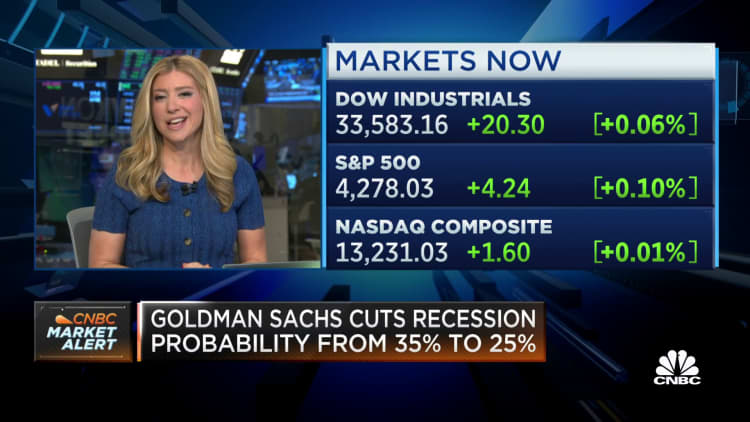Employment sign and sale sign are displayed at a retail store in Carlsbad, California, May 25, 2023.
Thank you for reading this post, don't forget to subscribe!Mike Blake | Reuters
The widely predicted U.S. recession remains out of sight as the first half of 2023 winds down, but the consumer sector that has fueled a remarkable recovery from the pandemic shutdowns may finally be showing signs of fraying.
The signals that economists lean on to gauge the odds of a recession are contradictory at the moment. The yield curve remains deeply inverted, and manufacturing surveys have been flashing recession signals for months. But layoffs concentrated in the tech sector have not spread widely so far, and there are pockets of consumer strength, such as travel, that look like a downright boom.
With the Federal Reserve expected to skip a rate hike at its next meeting, hopes of a so-called “soft landing” for the economy have begun to sprout again. On Tuesday, Goldman Sachs lowered its odds of a U.S. recession in the next 12 months to just 25%.

But can the strong consumer sector continue to hold up as the pandemic-era savings fade away and interest rates remain elevated? Not everyone is convinced, with some Wall Street strategists and economists arguing that a recession is just a matter of time as the central bank tries to bring down inflation — and there is plenty of evidence for that pessimistic case.
“The US and global expansions stand on solid ground, and fears of an imminent recession look overblown. This is the message from the latest releases showing a surprising increase in the global manufacturing PMI alongside strong gains in US goods spending and employment. But these data also suggest that the seeds for an end to expansion are being sown,” JPMorgan global market strategist Marko Kolanovic said in a note to clients on Monday.
The confusing consumer
The housing market is one of the key bellwethers for the U.S. consumer and the economy, and also one of the most confusing.
New home sales have actually been trending upward again in recent months despite elevated mortgage rates and a regional banking crisis, reversing some of a sharp slowdown from last year.
However, that may not be a great read on the health of the consumer this time around. There has been a dramatic decline in the number of existing homes being placed on the market, which is exacerbating the national housing shortage and could make demand look stronger than it truly is.
“If you own a home, if you locked in a 2.8% 30-year mortgage, that’s the best trade of your life. Unless you have to move, you’re not going to move,” said Lauren Goodwin, economist and portfolio strategist at New York Life Investments.
There are also conflicting signals coming from major consumer companies. Target warned last month of sluggish sales, and Dollar General‘s stock plunged on June 1 after the discount retailer slashed its full-year outlook.
Dollar General’s stock fell sharply after the retailer cut its full-year outlook.
But on the other hand, American Airlines raised its earnings guidance on May 31, citing stronger demand and cheaper fuel. And luxury apparel brand Lululemon topped estimates for earnings and sales for its fiscal first quarter and raised full-year guidance.
That divergence could be a continuation of the post-pandemic economy, which has seen consumers splurge in areas like travel while leaving some retailers caught off guard with their inventory plans. But it also could be a sign that the economic recovery is becoming “K-shaped,” Goodwin said. That means a situation where different income tiers of consumers diverge from one another.
“I don’t want to dismiss the idea that some companies could have idiosyncratic issues around their inventory management. It’s always a part of the story. But we’re seeing in the aggregate data a major bifurcation between lower- and middle-income segments of the consumer to the broader economy and the higher-income consumers,” she said.
“The bifurcation is happening not only by income segment but also by age,” Goodwin continued, pointing to credit card default rates.
“What that says to me is this is a story about wealth just as much as excess savings,” she added.
Labor market’s last stand?
The main source of optimism for the U.S. economy is the labor market, and continued job growth would boost low-income consumers and help fight off the K-shaped economy.
Even with reports of new rounds of layoffs from major companies including Meta Platforms, Disney and Goldman Sachs, the monthly jobs reports continue to beat expectations. The April JOLTS report even showed a surprise rise in job openings.
However, Nick Bunker, the economic research director for North America at jobs site Indeed, said his firm’s data shows that job listings have continued to soften in recent weeks and that the employment market has cooled since earlier in the recovery.
“Things are moderating, even if they’re still very strong,” Bunker said.
And the May jobs report was a conflicting document in and of itself. While payrolls gained a surprising 339,000 jobs, the unemployment rate — calculated by a different survey — actually rose to 3.7%.
“It’s just one of those quirky reports. That 3-10ths of a percentage point jump in the unemployment rate — I don’t think that’s an accurate representation of the health of the labor market. I also don’t think the 339,000 jobs we added in one month is an accurate reflection … My view of this is I would not get too hyped in either direction,” Bunker said.
The labor market is often seen as a lagging indicator of economic weakness, and it’s no guarantee that a recession is not around the corner. On Thursday, initial jobless claims showed a surprise jump to 261,000, potentially a warning sign that the cracks in the labor market are beginning to widen.
— CNBC’s Michael Bloom contributed reporting.


